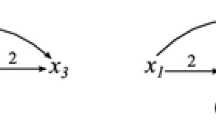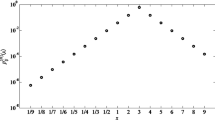Abstract
Evaluating the level of inconsistency of pairwise comparisons is often a crucial step in multi criteria decision analysis. Several inconsistency indices have been proposed in the literature to estimate the deviation of expert’s judgments from a situation of full consistency. This paper surveys and analyzes ten indices from the numerical point of view. Specifically, we investigate degrees of agreement between them to check how similar they are. Results show a wide range of behaviors, ranging from very strong to very weak degrees of agreement.




Similar content being viewed by others
References
Aguaròn, J., & Moreno-Jimènez, J. M. (2003). The geometric consistency index: approximated threshold. European Journal of Operational Research, 147(1), 137–145.
Anholcer, V., Babiy, V., Bózoki, S., & Koczkodaj, W. W. (2011). A simplified implementation of the least squares solution for pairwise comparisons matrices. Central European Journal of Operations Research, 19(4), 439–444.
Barzilai, J. (1998). Consistency measures for pairwise comparison matrices. Journal of Multi-Criteria Decision Analysis, 7(3), 123–132.
Bózoki, S. (2008). Solution of the least squares method problem of pairwise comparison matrices. Central European Journal of Operations Research, 16(4), 345–358.
Brunelli, M. (2011). A note on the article “Inconsistency of pair-wise comparison matrix with fuzzy elements based on geometric mean” [Fuzzy Sets and Systems 161 (2010) 1604–1613]. Fuzzy Sets and Systems, 161(1), 1604–1613. 2010, Fuzzy Sets and Systems, 176, 76–78.
Brunelli, M., Critch, A., & Fedrizzi, M. (2013). On the proportionality between some consistency indices in the AHP. Applied Mathematics and Computation. doi:10.1016/j.amc.2013.01.036.
Cavallo, B., & D’Apuzzo, L. (2009). A general unified framework for pairwise comparison matrices in multicriterial methods. International Journal of Intelligent Systems, 24(4), 377–398.
Cavallo, B., & D’Apuzzo, L. (2010). Characterizations of consistent pairwise comparison matrices over abelian linearly ordered groups. International Journal of Intelligent Systems, 25(10), 1035–1059.
Choo, E., & Wedley, W. (2004). A common framework for deriving preference values from pairwise comparison matrices. Computers & Operations Research, 31(6), 893–908.
Chu, A. T. W., Kalaba, R. E., & Springarn, K. (1979). A comparison of two methods for determining the weights of belonging to fuzzy sets. Journal of Optimization Theory and Applications, 27(4), 531–538.
Cohen, J. (1968). Weighted kappa: nominal scale agreement with provision for scaled disagreement or partial credit. Psychological Bulletin, 70(4), 213–220.
Crawford, G., & Williams, C. (1985). A note on the analysis of subjective judgement matrices. Journal of Mathematical Psychology, 29(4), 25–40.
Duszak, Z., & Koczkodaj, W. W. (1994). Generalization of a new definition of consistency for pairwise comparisons. Information Processing Letters, 52(5), 273–276.
Fedrizzi, M., & Brunelli, M. (2009). Fair consistency evaluation for reciprocal relations and in group decision making. New Mathematics and Natural Computation, 5(2), 407–420.
Golden, B. L., & Wang, Q. (1989). An alternate measure of consistency. In B. L. Golden, E. A. Wasil, & P. T. Harker (Eds.), The analytic hierarchy process, applications and studies (pp. 68–81). Berlin: Springer.
Karelaia, N., & Hogarth, R. M. (2008). Determinants of linear judgment: a meta-analysis of lens studies. Psychological Bulletin, 134(3), 404–426.
Koczkodaj, W. W. (1993). A new definition of consistency of pairwise comparisons. Mathematical and Computer Modelling, 18(7), 79–84.
Linares, P. (2009). Are inconsistent decisions better? An experiment with pairwise comparisons. European Journal of Operational Research, 193(2), 492–498.
Miller, G. (1956). The magical number seven, plus or minus two: some limits on our capacity for processing information. Psychological Review, 63(2), 81–97.
Osei-Bryson, K.-M. (2006). An action learning approach for assessing the consistency of pairwise comparison data. European Journal of Operational Research, 174(1), 234–244.
Pelàez, J. I., & Lamata, M. T. (2003). A new measure of consistency for positive reciprocal matrices. Computers & Mathematics with Applications, 46(12), 1839–1845.
Phelps, R. H., & Shanteau, J. (1978). Livestock judges: how much information can an expert use? Organizational Behavior and Human Performance, 21(2), 209–219.
Ramík, J., & Korviny, P. (2010). Inconsistency of pair-wise comparison matrix with fuzzy elements based on the geometric mean. Fuzzy Sets and Systems, 161(1), 1604–1613.
Ramík, J., & Perzina, R. (2010). A method for solving fuzzy multicriteria decision problems with dependent criteria. Fuzzy Optimization and Decision Making, 9(2), 123–141.
Saaty, T. L. (1974). Measuring the fuzziness of sets. Journal of Cybernetics, 4(4), 53–61.
Saaty, T. L. (1977). A scaling method for priorities in hierarchical structures. Journal of Mathematical Psychology, 15(3), 234–281.
Saaty, T. L. (1980). The analytical hierarchy process. New York: McGraw-Hill.
Saaty, T. L. (1994). Highlights and critical points in the theory and application of the analytic hierarchy process. European Journal of Operational Research, 74(3), 426–447.
Salo, A. A. (1993). Inconsistency analysis by approximately specified priorities. Mathematical and Computer Modelling, 17(4–5), 123–133.
Salo, A. A., & Hämäläinen, R. P. (1995). Preference programming through approximate ratio comparisons. European Journal of Operational Research, 82(3), 458–475.
Shanteau, J. (1989). Psychological characteristics and strategies of expert decision makers. In B. Rohrmann, L. R. Beach, C. Vleck, & S. R. Watson (Eds.), Advances in decision research (pp. 203–215). Amsterdam: North-Holland.
Shanteau, J., Weiss, D. J., Thomas, R. P., & Pounds, J. (2003). How can you tell if someone is an expert? Performance-based assessment of expertise. In S. L. Schneider & J. Shanteau (Eds.), Emerging perspectives on judgment and decision research (pp. 620–642). Cambridge: Cambridge University Press.
Shiraishi, S., & Obata, T. (2002). On a maximization problem arising from a positive reciprocal matrix in the AHP. Bulletin of Informatics and Cybernetics, 34(2), 91–96.
Shiraishi, S., Obata, T., & Daigo, M. (1998). Properties of a positive reciprocal matrix and their application to AHP. Journal of the Operations Research Society of Japan, 41(3), 404–414.
Shiraishi, S., Obata, T., Daigo, M., & Nakajima, N. (1999). Assessment for an incomplete matrix and improvement of the inconsistent comparison: computational experiments. In Proceedings of ISAHP 1999, Kobe, Japan.
Slovic, P. (1969). Analyzing the expert judge: a descriptive study of a stockbroker’s decision processes. Journal of Applied Psychology, 53(4), 255–263.
Snedecor, G. W., & Cochran, W. C. (1980). Statistical methods. Ames: Iowa State University Press.
Spearman, C. E. (1904). The proof and measurement of association between two things. The American Journal of Psychology, 15(1), 72–101.
Stein, W. E., & Mizzi, P. J. (2007). The harmonic consistency index for the analytic hierarchy process. European Journal of Operational Research, 177(1), 488–497.
Thurstone, L. L. (1927). A law of comparative judgement. Psychological Review, 34(4), 273–386.
Weiss, D. J., & Shanteau, J. (2003). Empirical assessment of expertise. Human Factors, 45(1), 104–114.
Weiss, D. J., Shanteau, J., & Harries, P. (2006). People who judge people. Journal of Behavioral Decision Making, 19(5), 441–454.
Acknowledgements
We are very grateful for the reviewers’ thorough and constructive comments.
Author information
Authors and Affiliations
Corresponding author
Rights and permissions
About this article
Cite this article
Brunelli, M., Canal, L. & Fedrizzi, M. Inconsistency indices for pairwise comparison matrices: a numerical study. Ann Oper Res 211, 493–509 (2013). https://doi.org/10.1007/s10479-013-1329-0
Published:
Issue Date:
DOI: https://doi.org/10.1007/s10479-013-1329-0




